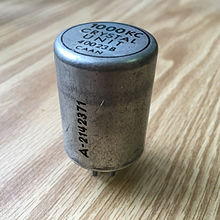Thecycle per secondis a once-common English name for the unit offrequencynow known as thehertz(Hz). Cycles per second may be denoted byc.p.s.,c/s,or, ambiguously, just "cycles" (Cyc., Cy., C, or c). The term comes from repetitive phenomena such assound waveshaving a frequency measurable as a number of oscillations, or cycles, per second.[1]
| Cycle per second | |
|---|---|
 A 1 MHz military-gradecrystal resonatorwith anoctal base,marked "1000 KC" for 1000 kilocycles per second. | |
| General information | |
| Unit of | Frequency, rotational frequency |
| Symbol | cps, c/s |
| Conversions | |
| 1 cpsin... | ... is equal to... |
| SI units | 1 Hz=1 s−1 |
With the organization of theInternational System of Unitsin 1960, the cycle per second was officially replaced by thehertz,orreciprocal second,"s−1"or" 1/s ". Symbolically," cycle per second "units are" cycle/second ", while hertz is" Hz "or" s−1".[2]For higher frequencies,kilocycles(kc), as an abbreviation ofkilocycles per secondwere often used on components or devices. Other higher units likemegacycle(Mc) and less commonlykilomegacycle(kMc) were used before 1960[3] and in some later documents.[4]These have modern equivalents such as kilohertz (kHz), megahertz (MHz), and gigahertz (GHz). Following the introduction of the SI standard, use of these terms began to fall off in favor of the new unit, with hertz becoming the dominant convention in both academic and colloquial speech by the 1970s.[5]
Cycle can also be a unit for measuring usage ofreciprocatingmachines, especiallypresses,in which casescyclerefers to one complete revolution of the mechanism being measured (i.e. the shaft of areciprocating engine).
Derived units includecycles per day(cpd) andcycles per year(cpy).
See also
edit- Cycles per instruction(CPI)
- Cycles per metre
- Heinrich Hertz
- Instructions per cycle(IPC)
- Instructions per second(IPS)
- MKS system of unitsa predecessor of the SI set of units
- Normalized frequency
- Radian per second
- Revolutions per minute(RPM)
- Turn (angle)
References
edit- ^Ewbank, Henry Lee; Lawton, Sherman Paxton (1940).Projects for Radio Speech: A Manual for the Student.New York: Harper & Brothers. p.151.
- ^Taylor, Barry N.; Thompson, Ambler, eds. (2008).International System of Units (SI)(PDF).Special Publication. Vol. 330 (2008 ed.). Gaithersburg, MD: National Institute of Standards and Technology. p. 27.Retrieved2019-09-02.
- ^Grammer, George (January 1933)."Rationalizing the Autodyne".QST.XVII(1). West Hartford, CN: American Radio Relay, Inc.: 11.Retrieved2019-09-02.
The 7000- and 14,000-kc. grid coils are wound with No. 18 enameled wire...
- ^Guentzler, Ronald E. (April 1967)."The" Monode "Noise Generator".QST.LI(2). West Hartford, CN: American Radio Relay, Inc.: 30.Retrieved2019-09-02.
The Monode described here is usable at frequencies below 144 Mc. with slight modification.
- ^"Kilocycle, Kilohertz, Megacycle, Megahertz".Google Ngram Viewer.2020-07-03.